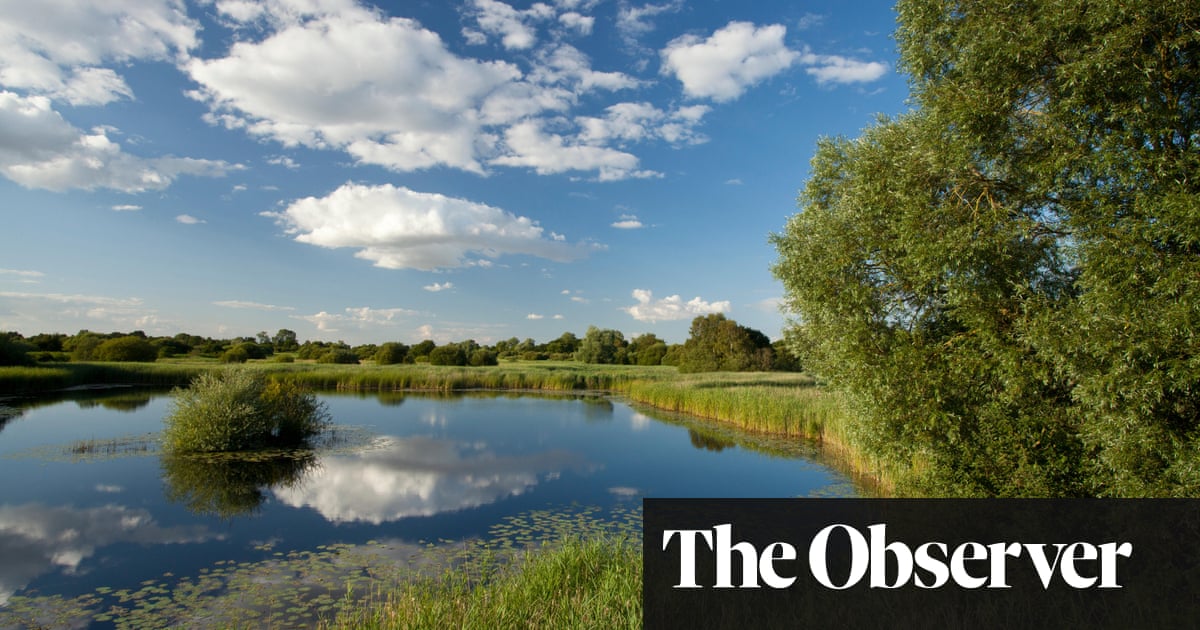
Looking north from Woodwalton Fen nature reserve, in Cambridgeshire, visitors get an uninterrupted view of Britain’s flattest landscape. An entire hemisphere of sky hangs over a network of carefully drained fields that stretch to the horizon without a hill or mound in sight. Potatoes and other root crops grow in profusion in the rich, peaty soil.
But change is coming to this quiet corner of fenland – thanks to one of the largest and most ambitious restoration schemes ever launched in Europe: the Great Fen project. Organised by Wildlife Trust conservationists, the project has already cost £10m and its price tag could reach £30m by the time it is completed, they say.
The money – which has included an £8m donation from the National Lottery Heritage Fund – is being used to buy large sections of farmland to create a 9,000-acre site around two nature reserves – one at Holme Fen and the other at Woodwalton Fen, the latter being one of the very first wildlife refuges created in the UK . The land will then be transformed by allowing water to return to previously drained fields, restoring it to its former damp glory.
Mosaics of pools, streams and water meadows will take over fields that recently brimmed with onions and carrots. Recreating these old habitats should then entice a host of animals and birds – from voles to kingfishers – into the Great Fen. Rare species that have already been recorded in the area include marsh harriers and scarce chaser dragonflies as well as plants such as cuckooflower, purple loosestrife and greater water parsnip.
“We have very high hopes for restoring biodiversity here,” said Henry Stanier, the project’s monitoring and research officer. “We should have all sorts of species - hobbies, bitterns, snipe and sticklebacks – coming in soon.”
New methods of farming will be tested at Great Fen to create types of agriculture that are sustainable and resistant to climate change, while the land will also be used to provide open access for visitors and ecotourists.
And central to these aspirations has been the purchase of Speechly’s Farm. This was completed a few months ago and is important because its land connects two separate chunks of rewilded countryside that have been developed around the Holme and the Woodwalton reserves. Thanks to the purchase of the farm, these two restored landscapes can be united.
“For the first time this century, we will have a continuous corridor of natural wet fenland that will stretch over thousands of acres of the Great Fen,” said Kate Carver, manager of the rewilding project. This point was backed by Lorna Parker, restoration manager for the Great Fen. “It’s quite simple. This piece of land is a game-changer for the project,” she said.
A major focus of the Great Fen project is its reserves of peat. The land in this East Anglian region was once thickly coated with peat, but it is now being lost at an alarming rate. It is estimated that every year a layer of about 2cm is destroyed as the land is drained and dried and peat is blown off as dust.
And that loss could have a crucial impact on the countryside. Peatlands reduce flood risk by slowing water flowing from upland areas; they provide nesting and feeding grounds for many wading birds; and they are vital habitats for rare insects and plants. Most importantly, however, they are key stores of carbon dioxide. “An acre of peatland holds as much carbon dioxide as an acre of rainforest,” said Parker. “Everyone worries about the rainforest but they forget that we are stripping back our peatlands at a terrible rate as well.”
The process of draining the Fens began in earnest in Victorian times with the development of powerful steam-driven pumps that brought dramatic changes to the landscape – as is revealed at Holme Fen reserve where, in 1848, a post was driven into the peat so that the top of it was at ground level. That post now towers four metres above the ground, demonstrating starkly how peat levels have shrunk over the past 170 years.
“We are now losing around 4.5m cubic metres of peat every year, and at this rate we will not have much left in a just couple of decades,” said Carver. “We have got to find ways of farming that do not use up our precious peat and do not increase carbon emissions.”
Part of the Great Fen project will therefore be to trial new farming systems that will not lead to peat loss and associated rises in carbon emissions. The solution is to employ wet farming techniques, or paludiculture, as it formally known.
As the water table rises in the area, the land will get wetter and a new range of crops will be grown. Candidates include bilberry, celery, cranberry, nettle, sedge grains, sweetgrass grains, watercress and water pepper.
“Systems which rely on having wet farmland could have all sorts of benefits,” said Carver. “It would help prevent the loss of carbon dioxide from dry arable land and it would prevent the loss of our supplies of peat which are dwindling at an alarming rate. These are our goals for the Great Fen project.”
This point was backed by Stanier. “This place is the cradle of conservation and it is entirely appropriate that it is going to help to make a real difference in our battle to preserve our biodiversity.”












